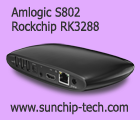Toshiba is doing a range of ARM Cortex-M series of processors used in a huge number of devices around the world.
M-Etic Game to showcases ARM Cortex-M0
Here are the parts used and their cost:
4x Linear Actuator – $240
96x RGB LED – $100
1x Infinity Mirror – $20
1x Joystick – $10
1x ARM Cortex-M0 – Less than $1
Raspberry Pi presents the $25 PC at ARM TechCon 2011
They plan mass production and deliveries by Christmas this year of the $25 ARM Powered PC. It’s basically a Broadcom ARM11 based SoC on a PCB with USB host, Ethernet, SD Card slot and a HDMI output.
Live video stream from ARM TechCon
I have a camera on my head and I will be walking around, hopefully you get smooth enough video, I’m using a T-Mobile 4G hotspot to upload the live video stream. I’m wearing a Kopin Golden-i headmounted computer to try to monitor the live ustream chat. Watch what I see while I video-blog here.
ARM Cortex-A15 processor 20nm tape out, it works!
Yes this is it, this is the next generation ARM Processor. The ARM Cortex-A15 processor is already being taped out. That means they are able to make the processor. In the next steps they tweak more things, it’ll take a few more months for fully configured ARM Cortex-A15 SoCs to be showcased and another few more months for those to reach products that can be sold to consumers on the market. The performance is huge. At the same clock speed the Cortex-A15 is said to be at least 50% faster than ARM Cortex-A9, but it can be made to run at much higher frequency, all the while using less power. This prototype does not include any GPU, it’s just an unoptimized ARM demo running some non-GPU Android. Look forward to my interviews to be posted during the next days with the ARM representatives talking about the features of this processor.
Cadence at ARM TechCon 2011
Cadence is one of the major EDA solutions provider. All the ARM Processor designers use their software to design the processors and all of the electronics that go inside of smartphones, tablets, laptops and more.
Magma Design Automation at ARM TechCon 2011
Magma is one of the 4 major EDA solutions providers, to provide design tools for chip design companies that make the worlds best ARM Processors. They help design, verify and make them work.
Common Platform technology
Samsung, IBM and Globalfoundries join forces to create the future of ARM Processors. They share knowledge, research and development costs, to bring amazing new technologies to products faster. They synchronize the process to ensure that customers’ chip designs can be produced at multiple sources in three different continents with no redesign required.
Synopsys EDA tools and IP at ARM TechCon 2011
Synopsys provides tools and IP for ARM chip designers for the ARM Cortex-A15, all the chip makers use their tools to design and verify the SoC.
PLDA PCI Express and USB3 for ASIC and FPGA
They can provide the IP to integrate PCI Express type 3 and USB3 on ARM Powered devices, for example and ARM Powered Laptop or Tablet.
Interview with the Texas Instruments OMAP4 team
The TI OMAP4 team answers some of my OMAP4 related questions. Check back in the next 3 days for some Texas Instruments related videos to be posted from here at the ARM Technology Conference.
– What caused the delay for OMAP4460 1.5Ghz availability?
TI collaborates consistently with customers, ensuring the resulting products are effectively leveraging the OMAP platform to meet their device needs. The OMAP4460 processor is capable of running up to 1.5GHz. Devices on the market today are leveraging that same processor at 1.2GHz. Expect OMAP4460 processor-based devices running at 1.5GHz in the near future.
– Are OMAP4 at 1.2Ghz OMAP4460 or OMAP4430 type? How does Video playback, GPU, memory bandwidth differ between 1.2Ghz and 1.5Ghz for OMAP4? Any other differences other than clock frequency?
Both the OMAP4430 and OMAP4460 processors are clocked at 1.2GHz in recently announced devices, the Droid RAZR and Samsung Galaxy Nexus respectively. Experiences are fairly consistent with both clock speeds, but the 1.5GHz gives an extra boost. The main upgrades to the OMAP4460 processor are an increased GPU performance and improved external memory access performance.
– How much faster is the OMAP4460 memory bandwidth compared to the Tegra2 devices that are on the market? Are we talking 7.5Gbitps vs 2.5Gbitps? Which other improvements would you say OMAP4460 provides over Tegra2?
The OMAP4460 processor delivers class-leading, dual-channel LPDDR2 memory architecture, vastly superior to competitive offerings, including Tegra 2. This memory capacity mixes with our smart-multicore approach in using specialized hardware to offload tasks from the main ARM processor to meet lower power consumption. Our video accelerator plus dual Cortex-M3 cores present a good example: all video standards are accelerated without using the main ARM MHz, and we achieve lower power than competitive devices that use more of the main ARM. Even with a fifth core, competition will still consume more power than dedicated hardware.
The OMAP4460 processor also includes 13 video decoders in the hardware – 4X the support of competitive offerings – and the highest level of mobile security for end-to-end protection. The OMAP 4 platform’s fully end-to-end security and video performance were key to its use in the Motorola Droid RAZR—the first device certified to stream premium Netflix content in HD. Click here for our related Mobile Momentum post.
– How does OMAP4460 compare with Samsung Exynos 4210 1.2Ghz in the Samsung Galaxy S2 (european version)? How does it compare with Qualcomm MSM8660 1.5Ghz in Samsung Galaxy S2 (us version)?
First, I’d like to add that the OMAP4430 is leveraged in the Samsung Galaxy S2 (Asia version), as well. The differentiators mentioned in the above question/response apply here as well. Since OMAP4460 processor-based devices are not yet on store shelves, there are no public benchmarks available at this time. However, we can say that the performance + power balance of the OMAP4460 exceeds that of competitors, similar to how its predecessors do on devices today. For example, we see today that Qualcomm’s MSM8260 graphics performance enables about 75 percent of what OMAP4430 processors can enable. Qualcomm claims a 1.5x performance improvement for the MSM8960 Adreno225, the resulting performance will land between that of OMAP4430 and the OMAP4470 capabilities. TI will still lead with the graphics performance of the OMAP4460 and OMAP4470 offerings.
– How does OMAP4460 compare with Apple A5 in iPhone 4S? How does OMAP4460 SGX540 compare with the Apple A5 SGX544? Is the OMAP4 configuration higher clock frequency on the GPU?
The architecture of the OMAP platform as a whole hinges on a sophisticated balance between the best performance and ultra-low power consumption. We’ve spent a decade+ perfecting this balance. We are not in the business of speeds and feeds, where merely cranking up a core’s speed is acceptable or appropriate. At TI, we believe that the GPUs, the CPUs and every other element in the platform must be in sync to achieve optimal performance across the system. And, we consistently deliver on that—finely tuning the performance levels to what each OMAP processor chassis ideally supports.
With that said, we’ve seen competitors increase, for example, their GPU performance with dramatic trade-offs. Those trade-offs typically mean larger die sizes—some at ~50% larger than the OMAP4460 processor—and greater power consumption, which in turn incur higher costs for the OEM and higher power loss for the end user. What’s more, end device applications have not yet caught up with the highest graphics performance delivered by these competitors. So, the competitive solutions are increasing costs, board space and power usage to provide performance that cannot be used by the end consumer.
TI, instead, remains focused on delivering OMAP processors with performance that is viable and highly-effective for our customers and, ultimately, their customers—the end user. Staying with the GPU example, the OMAP4460 processer includes the SGX540 GPU with dual channel memory and DSS. This graphics core is running at an increased speed compared to its preceding performance on the OMAP4430—delivering greater performance without draining power. This OMAP capability, along with the platform’s overall smart multicore architecture and offloading to cores more appropriate for tasks is a part of why the OMAP4460 is used in Google’s Ice Cream Sandwich GED—the Galaxy Nexus. The OMAP4460 competitively provided the best performance on all fronts within the ideal power envelope.
– How does OMAP4460 1.5Ghz compare with some of the latest Intel Atom in a netbook form factor? Can we run unlimited amounts of tabs in Chrome OS and Ice Cream Sandwich full screen HD web browsers?
The OMAP architecture is built upon the high performance + low power balance. The latter part of that equation is one that some competitors – including Intel – have yet to prove on mobile form factors. Yes, we can support multiple tabs on HD browsers.
– Is Flash11 fully hardware accelerated on OMAP4 yet? How soon is it ready? Does it mean 1080p Flash plays 100% smoothly in full screen on Android?
TI and Adobe have a deep working relationship, and currently have Flash video fully accelerated supporting 1080p Flash video. TI will continue to optimize the performance as new generations of Flash are released.
– Which benchmarks in Android show the full performance of OMAP4460? Are there any tweaks that you, Google or manufacturers can make to improve benchmark results for how OMAP4460 devices should compare with Tegra2, Exynos 4210, MSM8660 devices?
The only announced OMAP4460 processor device is the Samsung Galaxy Nexus. Because this device has not launched, there are no public performance benchmarks currently available.
– How does OMAP4460 1.5Ghz compare with Nvidia Tegra3 Kal-El? How does OMAP4470 1.8Ghz compare with it? Is it correct to consider that an OMAP4470 dual-core 1.8Ghz mostly performas faster than a Tegra3 quad-core 1.2Ghz? How soon are you shipping OMAP4470 and is it nearly fully compatible with OMAP4460 designs making the upgrade relatively simple for manufacturers?
As mentioned in the above response, the OMAP4460 and OMAP4470 processors offer various benefits over Nvidia’s comparative solutions. The OMAP4460 processor delivers class-leading, dual-channel LPDDR2 memory architecture, vastly superior to competitive offerings, including Tegra 2. This memory capacity mixes with our smart-multicore approach in using specialized hardware to offload tasks from the main ARM processor to meet lower power consumption. Our video accelerator plus dual Cortex-M3 cores present a good example: all video standards are accelerated without using the main ARM MHz, and we achieve lower power than competitive devices that use more of the main ARM. Even with a fifth core, competition will still consume more power than dedicated hardware. The OMAP4460 processor also include 13 video decoders in the hardware – 4X the support of competitive offerings – and the highest level of mobile security for end-to-end protection.
Moving to the next generation, the OMAP4470 processor is not just faster ARM speed. It is optimized for large screen form factors with 2D/3D accelerators and dual-channel memory. An example is a 1080p VTC with UI composition on a WUXGA screen – this uses up to 5GBps of memory. Competitors’ processors with single-channel memory simply cannot deliver, and dual-channel, non-interleaved competitive solutions run out of steam as well.
The OMAP4470 processor is expected to sample in the second half of 2011, with devices expected to hit the market in first half 2012. The OMAP4470 processor has complete pin-to-pin hardware and software compatibility, allowing rapid transition and maximum re-use of investment from OMAP4430 and OMAP4460 processors.
– I’d understand that Google does not let you say, but if OMAP4460 is reference platform for Ice Cream Sandwich, does that mean Android 4.0 can be used for Smartphones, Tablets, Laptops, Set-top-boxes and combinations thereof also? Any thing to say about how advanced you have become working with Linaro, with Canonical, Google on Chrome OS or Google TV (if those aren’t yet fully combined in Ice Cream Sandwich)?
TI’s OMAP4460 processor is indeed the processor of choice for Ice Cream Sandwich. Check out our Mobile Momentum blog post for more: click here. We envision Android 4.0 running on a slew of OMAP 4 processor-based form factors, from smartphones to tablets, ultra-thin computing devices and more. In terms of the last part of your questions, we can’t comment on any engagements beyond those that are public. What’s more – we’re excited that the OMAP4460 processor is the processor of choice for the first Android OS that can port from Smartphones to Tablets.
Overall, we have very strong, working relationships with the groups you mentioned.
Live streamed from ARM TechCon, archive 1
I streamed a bit from ARM TechCon today using my headmounted live camera. I tried to monitor the live Ustream chat in my OMAP3 powered Kopin Golden-i headmounted computer system. Check back in the next 3 days for more live video streaming and for my full HD video coverage with interviews with ARM industry insiders, ARM chip designers, foundries and more.
ARM Techcon 2011 (October 25-27th), look for awesome video-blogging here during the next 3 days
Look forward to 3 days of awesomeness from the ARM Technology Conference here in Santa Clara. All the major ARM chip makers are here to present the latest, newest and fastest ARM processors ever, to be in all future Smartphones, Tablets, Laptops, Set-top-boxes, E-readers and more.
Look at the list of exhibitors, do some searches on Google Blogsearch, Google+ and Twitter, then please write here in the comments any interesting topics that you think that I should film in priority, please write your suggestions for questions that I should ask to the ARM related companies here at the conference.
Claudia Urrea, Director of Learning for Latinoamerica at One Laptop Per Child
She’s the manager of Learning at One Laptop Per Child, she provides some insights into how the Laptops can be measured to be successfully deployed to children in schools around the world.
Giulia D’Amico, Director of Business Development at One Laptop Per Child
Giulia D’Amico is currently the Director of Business Development, EU Affairs and Africa at One Laptop per Child Association in Miami.
OLPC Summit: Bernie Innocenti
He now works at Google, he worked on the Sugar software of the OLPC project.
This video was filmed using the new JVC GC-PX10 camcorder at 36mbitps 1080p50 with the JVC MZ-V8/MZ-V10 external microphone, you can download the full sample file here on Google Docs
Daniel Drake on doing OLPC Deployments
Daniel Drake is working on deploying OLPC all over the world. He provides technical support, training the local technical teams, how to repair laptops, how to setup the school servers and more.
This video was filmed using the new JVC GC-PX10 camcorder at 36mbitps 1080p50 with the JVC MZ-V8/MZ-V10 external microphone, you can download the full sample file here on Google Docs
Christoph Derndorfer and SJ Klein discuss the status of OLPC
Christoph Derndorfer is the managing editor at the unofficial http://olpcnews.com website and SJ Klein is the director of outreach, community content coordinator at One Laptop Per Child.
This video was filmed using the new JVC GC-PX10 camcorder at 36mbitps 1080p50 with the JVC MZ-V8/MZ-V10 external microphone, you can download the full sample file here on Google Docs
OLPC Summit: Jamaica
Craig Perue launched the OLPC Project in Jamaica, currently reaching two schools with about 95 laptops, but preparing to be able to bring all the Children of Jamaica access to this project if only they can find funding.
This video was filmed using the new JVC GC-PX10 camcorder at 36mbitps 1080p50 with the JVC MZ-V8/MZ-V10 external microphone, you can download the full sample file here on Google Docs
OLPC Summit: Vietnam
Nancie Severs started a small laptop deployment in a remote village in Vietnam. They currently are about to have 18 laptops in that village. Find more information at http://wiki.laptop.org/go/OLPC_Vietnam
This video was filmed using the new JVC GC-PX10 camcorder at 36mbitps 1080p50 with the JVC MZ-V8/MZ-V10 external microphone, you can download the full sample file here on Google Docs



